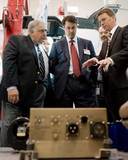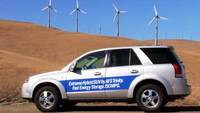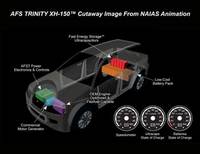2008 Detroit Auto Show: AFS Trinity Unveils 150 MPG 'Extreme Hybrid' SUV - 3 VIDEOS
Company releases proving ground data, Details new "Fast Energy" technology for plug-in hybrids
EDITOR'S NOTE: This page contains 3 different videos that graphically address each of the points in this. Please scroll down the page to watch each.
DETROIT - January 13, 2008:
 |
AFS Trinity CEO Edward W. Furia provided details of the tests and the patent pending Fast Energy Storage(TM) system that makes the Extreme Hybrid(TM) possible. During Furia's report, a second, identically-equipped and fully functional SUV demonstrator of the XH(TM) technology was unveiled and will remain on display throughout the Auto Show.
Click PLAY to watch this video
"Extreme Hybrids(TM) don't need high priced technology and don't require new or expensive fuels, such as hydrogen, which, according to Argonne National Labs, will cost twice as much as gasoline at the pump and require installation of an infrastructure costing half a trillion dollars. The Extreme Hybrid(TM) is not a concept," Furia said, "but a practical alternative that relies on cheap electricity from America's vast existing energy infrastructure -- the electric power grid." Furia also pointed to a recent U.S. DOE study that concluded sufficient excess electrical generating and transmission capacity exists today during off-peak hours in America's power grid to recharge 84% of America's light duty car, truck and SUV fleet-184 million vehicles-even if they were all converted to plug-in hybrid drive trains.
TEST RESULTS
According to Furia, the Extreme Hybrid(TM) tests just completed at
Michelin's Laurens Proving Grounds in South Carolina produced ...
-- More than 150 miles per gallon of gasoline based on the EPA Combined
Urban/Highway Driving Cycle with 6 days per week of 40 miles per day
in all electric mode and one day at 100 miles with assistance of the
gas engine. Different driving patterns will produce different results.
-- 40 mile all-electric range on a single, overnight charge.
-- Extended range of 400 miles with hybrid operation.
-- Rapid acceleration in all modes of operation, including all electric
mode in which no gasoline is burned at all.
-- Highway speeds up to 87 miles per hour in either all electric or
hybrid mode.
-- Even faster acceleration and higher speeds possible in future
production models should the company decide to configure them for such
performance.
Click PLAY to watch this video
AFS TRINITY XH-150(TM) PERFORMANCE COMPARISON TABLE
AFS Trinity 2008 Lexus 2007 Saturn Vue 2008 Chevrolet
XH-150(TM) RX400h Greenline Tahoe Hybrid
Combined City/
Hwy Mileage 150 MPG 25 MPG 26 MPG 20 MPG
0-60 time
-- Full Hybrid
mode 6.9 secs 7.5 secs 12.5 secs 8.1 secs
-- All-electric
mode 11.5 secs
-- Mild Hybrid
mode 12.5 secs
Top Highway Speed 87 MPH 116 MPH 106 MPH 112 MPH
Weekly Gasoline
Cost $7.93 $47.60 $45.77 $59.50
Weekly Electricity
Cost $7.56 $0.00 $0.00 $0.00
Total Weekly Fuel
Cost $15.49 $47.60 $45.77 $59.50
1. Fuel economy figures for Chevrolet Tahoe, Toyota RX400h, Saturn Vue
Greenline reflect published data citing latest 2008 EPA calculation
method.
2. Weekly fuel cost based on gasoline at $3.50/gallon and 40 miles/day of
driving Monday through Saturday and 100 miles of driving on Sunday for
a total of 340 miles.
3. Tahoe top speed estimated based on 2007 conventional Tahoe.
4. Fuel economy figures for XH-150(TM) based on projections of mixed
urban/highway drive cycle.
5. Electricity cost based on PG&E off-peak EV charging rate of 6
center/kWh.
6. Top speed based on transmission limit. Higher speeds possible with
other components.
7. Although the XH(TM) system can be optimized for fuel economy, top
speed or acceleration, fuel economy is the company's priority.
"Keep in mind that these results were not in a small two-seater, but in a medium-size family SUV designed to support a serious supermarket run or a family's weekend recreational activities," Furia said.
LICENSE OR MANUFACTURE
According to Furia, the next step for AFS Trinity is to license its
breakthrough technology to carmakers who want to incorporate the XH(TM)
drive train into their vehicles. "That would be our preference," said
Furia.
"However," he continued, "If carmakers decide not to take advantage of this offer, AFS Trinity intends to raise the funds to begin modifying existing hybrids or manufacture its own 150 mpg SUV's and, eventually, 250 mpg sedans. We believe such production models could be available for sale in three years."
Furia explained, "The SUVs that we just completed that were outfitted with the XH(TM) drive train could have been any SUV made by anyone. The XH(TM) is a new generation of plug-in hybrid drive train ready to multiply the gas mileage of any SUV or any standard sedan."
'XH' WILL PAY FOR ITSELF
"In spite of growing popularity of hybrid vehicles," Furia said, "none
of them have delivered gasoline savings sufficient to repay the purchase
price premium of the hybrid system during the useful life of the vehicle.
With the Extreme Hybrid(TM) that is about to change."
Extreme Hybrid technology in commercial production is expected to cost around $8,700 more than current, gas-only SUV's. "However, if the price of gasoline is, say, $2.85 per gallon, XH(TM) gasoline cost savings could repay the purchase price premium in 3.5 years," Furia said. "The higher fuel prices go, of course, the faster the premium is repaid. At a price of $5 a gallon, which is the price already being paid in parts of the world, the premium could be repaid in less than three years and the savings would continue to grow. Tax and other incentives could accelerate this process."
Click PLAY to watch this video
ROCKET SCIENTISTS AND CAR GUYS
The technology that made these results possible came from the former
space and atomic energy scientists at AFS Trinity's Livermore, California,
laboratory with integration of the technology into the American SUVs made
possible by respected global automotive engineering leader, Ricardo.
"This has been a collaboration of rocket scientists and car guys," Furia said. "They have taken the best from aerospace and computer science as well as automotive engineering to produce in a very short time frame and largely with off-the-shelf components a working vehicle prototype in which the XH(TM) plug-in hybrid drive train has been demonstrated in a family-size SUV."
A SOLUTION READY NOW
Furia said, "The Extreme Hybrid drive train is an economical solution to
the high cost of gasoline, the dangers of oil dependence and the
environmental damage caused by too much gasoline being used to travel too
few miles."
"This is a time in automotive development where many promises have been made and a wait-and-see attitude has developed," Furia said. "The XH-150 is not a promise but a fact with 'tires to kick.' The XH-150 does not require exotic or controversial fuels, it works within the present energy infrastructure, and components are available off-the-shelf at reasonable prices -- prices that will only drop lower as volume demand increases. Just as important, XH(TM) production vehicles are capable of being built now at prices many people can afford."
AFS Trinity issued a 14-page summary of key factors surrounding the XH-150, including how the Extreme Hybrid technology works. (Editors' note: If the summary is not attached it is available as .pdf file by emailing hq@afstrinity.com).
Furia also invited review of the XH-150 data gathered during road tests at Michelin's Laurens Proving Grounds by visiting www.afstrinity.com.
TECHNICAL BREAKTHROUGH
"Addressing the central limitations of chemical batteries was critical
to creating the Extreme Hybrid," Furia explained. "Batteries work best when
they provide a slow, steady flow of electricity. Offering enough power for
fast acceleration is difficult and damaging to batteries, and this is
especially true as batteries become deeply discharged."
"The most common solution is to employ many more batteries and simply shallow-discharge them, which is impractical for all but expensive, exotic vehicles. Instead, the Extreme Hybrid accesses AFS Trinity's long history of developing Fast Energy(TM) solutions for NASA, the U.S. Department of Defense and others. At the heart of this new Fast Energy(TM) technology are patent pending control electronics to cache power for short periods in ultra-capacitors and provide this power in bursts for all-electric acceleration that is better, in many cases, than the internal combustion engine of the host vehicle," Furia said. "Until the Extreme Hybrid, hybrids have resorted to gasoline to satisfy acceleration demands."
SAFETY BREAKTHROUGH
According to Furia, one reason carmakers have resisted plug-in hybrids
has been reports of some isolated, but troubling fires involving lithium
batteries in laptops that were pushed beyond thermal limits. "All devices
through which currents are drawn experience some resistive heating,
including all types of batteries. Batteries can be safe if they avoid
excessive resistive heating. By using ultra-capacitors as pools of rapid
energy," Furia explained, "the proprietary control electronics of the
Extreme Hybrid(TM) not only keep the batteries within safe resistive
heating limits, but also extend battery life. We regard XH(TM) technology
as an important safety breakthrough, which is a critical factor in making
Extreme Hybrids(TM) practical now."
CALCULATING MILEAGE
"Gasoline mileage is calculated by using average American driving
patterns estimated by the U.S. Department of Transportation and simulating
the EPA combined urban/highway driving cycle of the host vehicle operating
only with its conventional hybrid drive train. In 2003, the U.S. Department
of Transportation reported that 78% of Americans drive less than 40 miles a
day. On those days, drivers of Extreme Hybrids will need no gasoline at all
-- even driving an SUV," Furia said.
"Say someone drives 40 miles a day 6 days a week and 100 miles the seventh. That's 340 miles a week. The first 280 are electric. The next 60 miles use gas. That's 340 miles on a little more than two gallons of gasoline for the week, assuming 32/29 urban/highway mileage in the host unmodified hybrid SUV. Although this translates into 170 MPG, we use a more conservative 150 MPG to take into account that mileage will vary depending on where and how a car is driven, but we are comfortable that 150 miles per gallon of gasoline is a good number."
ABOUT AFS TRINITY
AFS Trinity is a privately-owned Delaware corporation headquartered in
Bellevue, WA, that is developing Fast Energy Storage(TM) and power systems
for vehicular, spacecraft and stationary power systems utilizing batteries,
ultracapacitors, and flywheels. The Company has conducted programs with
private and government organizations including DARPA, NASA, the U.S. Navy,
U.S. Army, U.S. DOT, California Energy Commission, Oak Ridge National
Laboratories, Lawrence Livermore National Labs, Lockheed, Honeywell and
Ricardo. Although AFS Trinity is not currently using flywheels in systems
that are designed for consumer cars, it is actively engaged in developing
flywheel power systems for Formula One Racing (F1) and is currently also
engaged in developing such a system for one of the world's top F1 teams.
American Flywheel Systems, Inc (AFS) received the first patent ever given
for a flywheel battery in 1992 and merged with Trinity Flywheel Power to
create AFS Trinity Power in 2000. AFS Trinity and Ricardo, Inc. have a
Technology Partnership Agreement by which Ricardo is assisting AFS Trinity
as a preferred customer and is installing into passenger vehicles AFS
Trinity's Extreme Hybrid(TM) drive train technology, technology which is
the subject of ongoing AFS Trinity U.S. and international patent filings.
For more information, see http://www.afstrinity.com/.
ABOUT RICARDO
With technical centers and offices throughout Europe, the US and Asia,
Ricardo is a leading independent technology provider and deep-content
strategic management consultant to the world's transportation sector
industries. The company's engineering expertise ranges from vehicle systems
integration, controls, electronics and software development, to the latest
driveline and transmission systems and gasoline, diesel, hybrid and fuel
cell powertrain technologies. Its customers include the world's major
automakers, tier 1 suppliers and leading motorsport teams. The headquarters
of Ricardo's US operations, Ricardo, Inc., is located at Van Buren
Township, Michigan. The company's skill base represents the state of-
the-art in low emissions and fuel-efficient powertrain technology, and can
be best summarized: "Ricardo is Fuel Economy." Ricardo plc posted sales of
$344 million in financial year 2007 and is a constituent of the FTSE
techMark 100 index -- a group of innovative technology companies listed on
the London Stock Exchange. For more information visit
www.ricardo.com.
Extreme Hybrid(TM), XH(TM), XH-150(TM), XH-250(TM), Fast Energy(TM), Fast Energy Storage(TM), Just Plug It In(TM), Powered by XH(TM)are trademarks pending of AFS Trinity Power Corporation Patents Pending -- All Rights Reserved -- (C) 2007 AFS Trinity Power Corporation




